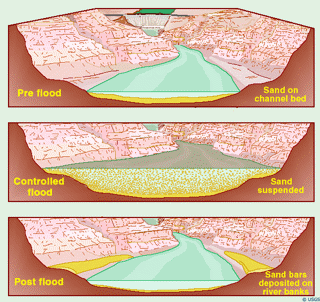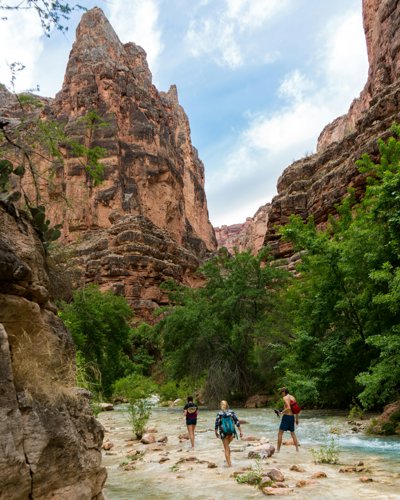November 2004
River processes in the Colorado river are to be artificially managed in order to help re-build sandbanks and ecosystems devastated by the building of the Glen Canyon dam in 1963.
The Colorado is already one of the most highly managed rivers in the world. Feeding seven US states and Mexico, the natural regime of the river was completely altered during the 20th century. The Hoover Dam (1935) and the Glen Canyon Dam (1963) store enormous amounts of water, reducing peak discharge levels of the river and providing a source of water than can then be transported, via man-made constructions such as the Colorado Aqueduct, to thirsty desert cities like Las Vegas. However, these direct changes to river flow have had indirect impacts upon river processes and river valley landforms. Now, US government agencies are introducing new management measures aimed at modifying river processes (erosion, transport and deposition) to help restore natural sandbanks and ecosystems.
The Colorado’s regime
The regime of a river is its pattern of flow over a period of time, usually one year.
-
The Colorado’s discharge is naturally very uneven with a marked summer maximum and lower flow between September and April. The marked unevenness of summer and winter flow is attributable to its massive drainage basin. The Colorado covers seven US states, including Wyoming, Utah, Colorado and Arizona, within which a number of mountain ranges lie. It is the summer melt of snows in the Rockies, the Wind River Mountains and the Unita range that produce large amounts of overland flow in early summer and a pronounced rise in river levels. In extreme years of the early 20th century, discharge rose from 200 to 2,600 cumecs at Lee’s Ferry, prior to the construction of the Glen Canyon dam. During some years, a second peak in flow naturally occurs in the autumn around October, due to convectional rainstorms over the Colorado plateau.
-
However, water management schemes have radically altered the natural regime of the Colorado. Flood peaks have been smoothed out by dam building. The Hoover Dam (1935) can store the equivalent of two years’ river flow in Lake Mead. At Lee’s Ferry in Arizona, just downriver from the Glen Canyon Dam (1963), the mean annual flood has been reduced from 2,264 cumecs to 764 cumecs.
Source: Hilton, K. (1985) Process and Pattern in Physical Geography, Unwin Hyman, London, 108-14
Why is there a need to manage river processes?
The Glen Canyon dam was built approximately half-way along the course of the Colorado in Arizona and was completed in 1963. Its construction had the following impacts upon river processes and landforms:
-
Clearer water By functioning as a sediment trap, the natural silts and sands of the Colorado are prevented from travelling further downriver. Rates of transportation of sediments (both suspended load and bed load) are reduced to nearly zero. Below the dam, in Lee’s Canyon, the load of the river has been reduced by a factor of 200. Solutes can, of course, still be transported as they have been dissolved and are not trapped by barriers.
-
Disappearing sandbanks In turn, these transported sediments used to help build sandbanks lower down the river. As a result, changes have occurred to the Colorado’s alluvial morphology (the landforms that are dependent upon river deposits). Sandbanks along the sides of the river – often forming the slip-off slopes of meanders, have been starved of sediment and have been reduced in size.
-
Colder water The river water now has a much lower sediment load and is colder as a result, as transported particles can absorb heat (just as land heats up more quickly than water when the sun shines).
-
Vanishing species Shrinking sandbanks and colder water have modified the river ecosystem, leading to the loss of four of the Colorado’s natural fish species, including the squawfish. These species only spawn near sandy bars and thrive in silty, warm waters. They are also preyed upon by trout, who prefer clearer, cooler water and whose numbers have risen accordingly since 1963. In addition, plants and animals that live on the sandbanks –such as the Kanab snail and the willow flycatcher- have suffered decline.
-
Fishing and rafting The sandbanks also had human uses – for fishing and rafting – that cannot be pursued any more in some parts of the river.
These three sets of changes - shrinking sandbanks, vanishing species and the loss of a valuable leisure resource – mean that there is now a need to manage river processes and to attempt to restore the river’s natural equilibrium.
How are river processes being managed?
Following the recommendation of scientists, four giant steel pipes are now allowing the release of controlled amounts of water from the dam following periods of heavy rain or snow-melt. Run-off brings plenty of sediment into the dam at certain times of year. However, it quickly begins to settle at the bottom of the dam. There is already a depth of at least 20 metres’ sediment throughout much of the dam (it is predicted to fill up entirely within 400 years!) When new inputs of run-off arrive in the dam - bringing fresh sediments while also disturbing existing deposits - it is vital that the water is released quickly before sedimentation (re-settling of particles) can take place. For instance, late autumn thunderstorms in October led to the decision to release water this week (The Independent, 24 November 2004). The following will hopefully be achieved:
-
Higher discharge Discharge will temporarily rise to 41,000 cubic feet per second. This will provide the energy needed to transport large amounts of suspended silts, sands and gravels.
-
Increased transportation Over the 90-hour operation, 800,000 tons of sediment will be transported out of the Glen Canyon dam (this may, in turn, lead to higher rates of erosion near to the dam as there will be increased river energy and an abundance of suspended abrasional material - scientists will need to monitor carefully).
-
Increased deposition Further down-river, in sections where the Colorado’s channel shape changes to become wider and shallower, deposition will occur as the river loses energy due to its decreased hydraulic radius.
-
Natural system state restored As the river deposits its load sequentially (heaviest first), the sandbanks will begin to be restored. In the long-term it is hoped that the Colorado ecosystem may be restored closer to its original state and that one currently vanishing fish species – the humpback chub – will be saved.
Governance note: the cost of this scheme has been $3.7 million. It was supported by a partnership of a dozen government agencies, such as the Department of the Interior and the U.S. Geological Survey.

Writing about rivers at A Level
A Level Specifications require candidates to possess located knowledge of rivers, including their hydrology, regimes and in some cases river processes and landforms. It is vitally important that candidates understand the difference between flood management and river process management. This case study is clearly of relevance to the second of these two topics. For instance, students could prepare 6-mark responses for the following questions:
With reference to a named river, explain why there is a need for the management of river processes.
(6 marks)
With reference to a named river, explain how river processes are managed.
(6 marks)
